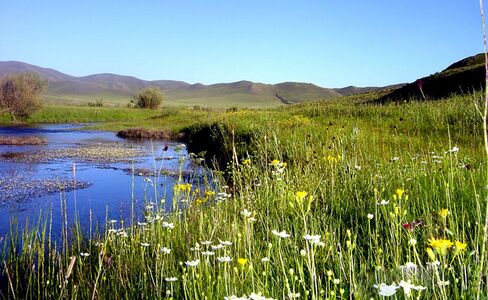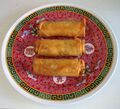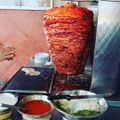Daxia
Democratic Republic of Corumm 昆仑 共和国 | |
|---|---|
|
Flag | |
Anthem: March of Joy | |
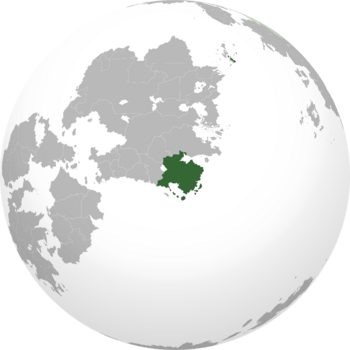 Corumm and its territories | |
| Capital and largest city | Mirzak |
| Official languages | Corummese |
| Ethnic groups |
|
| Religion | None |
| Demonym(s) | Corummese |
| Government | Republic |
• Chancellor | Prib Dodd |
| Legislature | People's Assembly |
| Establishment | |
• End of Old Night | 305 BCE |
• Era of Chaos ends | 423 CE |
• Heavenly Empire established | 645 CE |
• Glorious Revolt | 1957 |
• Demcratic Republic of Corumm | 1992 |
| Population | |
• Census | 698,168,695 |
| GDP (nominal) | estimate |
• Total | $26.6 trillion |
• Per capita | $36,222 |
| Currency | Lire (LIR) |
| Driving side | right |
| Calling code | +646 |
| Internet TLD | .cro |
Corumm, officially the Democratic Republic of Corumm is a state located in southeastern Alshar. It borders Rusana to the west, Canpei and Tanhai to the north and the Taizi Sea to the east and south. Corumm also has territories in north Crona and a smattering of island holdings. Its capital and largest city is Mirzak, a city with a population of over 20 million and the political and economic heart of the country. The largest and dominant ethnicity is the Corummese people, which number above 700 million people making it one of the more numerous groups on the continent. The Corummese language is the only official language although Rusani may be spoken and taught locally. Corumm is a medium income country with large industrial, agricultural and technological sectors, with economic growth seeing an uptick in recent years especially due to the opening of new markets in Crona and the flow of cheap raw materials from the colonies. Corummese mercantlism has seen Corummese companies spread out across the globe to open subsidiaries and acquire local firms, often with off the books government support.
Foreign policy-wise, the Corummese often like to take the long view and be cautious, which has led to accusations of being fence sitters and unprincipled in foreign affairs. Despite this, Corumm is considered a major power broker at the League of Nations where its diplomats are always carefully maneuvering and negotiating to push through or sink various initiatives. Corumm is also a nuclear power, developing its own arsenal in the 1960's and demonstrating its willingness to adopt a first strike policy, most recently in the atomic bombing of Shimrra. Politically the country is dominated by the Party of Corummese Democrats which has won every election since Linge Chens election in 1992. Internally Corumm is a vertically arranged state, with an all powerful office of Chancellor at the cusp wielding absolute power and authority, with virtually no checks and balances. The rule of the PCD is safeguarded by a potent and cruel military and pervasive security forces which keep a tight, choking grip on all sectors of society, even abroad. Historically, relations with its neighbors have been plagued by conflict and mistrust but this is changing in recent times. The people of Corumm are highly suspicious of foreigners and their barbaric customs and hold fast to several xenophobic attitudes.
Etymology
The etymology of the name Corumm is relatively well known. It is widely believed to be a derivation of the name Korun, identified in stone tables dating back to 5,000 BCE to be a location in central Corumm, specifically a mountain. These historical texts make reference to Korun as both a historical region and in the instance of the Korun mountain as the mythological home to the gods of an old pagan religion. The morphing of the word and pronunciation seems to have taken sometime in the late 1,000's possibly to disassociate the name from its religious connotation. The name Corumm was from then on associated with the polity of central Corumm that would slowly branch out in other directions.
History
Old Night
Era of Chaos Period

During this era several states vied for supremacy over one another. The strongest states were Cao, Mung, Zuo, Chen, Yang, Liao and Jin(later divided into Upper and Lower Jin). Other states existed during the period but were much shorter lived.
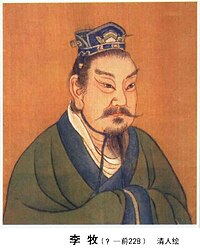
The balance of power often changed as temporal alliances were forged or broken. The appointment in 105 BCE of Prince Dorgon as chief minister of Yang and his military reforms mark the start of the 'Era of Yang Domination'. For most of this period Yang maintained a military alliance with the southern state of Cao, which enabled it to overtake Zuo by 12 BCE. Wars with Chen would last until its final destruction over 200 years later, with Yang reaching its greatest extent by 235 CE.
Despite its expansion, Yang could never comprehensively defeat its other neighbors and was riven by dynastic infighting that would fatally weaken it and give openings to rival states. As Yang became increasingly embroiled in wars on all sides, Cao eventually broke off its long standing alliance. During 368 CE, King Shisheng of Cao launched attacks on both Yang and Mung. Shisheng's successor, King Guofang, broke Mung's power and forced it into vassalage and pushed further into Yang, taking its capital and forcing the court to flee north. The loss of Dagu and the treasury provoked a palace coup against King Wen who was dethroned and executed by drowning. His 9 year old nephew was installed as King Wu of Yang and he ruled until the state's final destruction in 430 CE.
Supremacy of Cao Period
The progressive dismemberment of the Yang state allowed Cao to take its place as the new hegemonic power, now supported by Mung as a vassal state until 487 CE when its remaining independence was abolished. Several expeditions against Liao were undertaken but achieved limited gain due to the difficult mountainous terrain that favored the defender. The disastrous battle of Yanxi Pass where a 50,000 strong force was ambushed and destroyed put an end to Cao's military advances for the next 50 years, although it continued to claim overlordship over Liao. During this relatively peaceful period, the foundations of the imperial state were laid down. The highly bureaucratized system of governance, attempts at standardization of coinage and language and the expansion of a road system were products of this era.
By 552 the state of Upper Jin was attacked and reduced to a northern sliver of land, allowing Cao's forces a new avenue of invasion that avoided Liao's eastern mountain range. General Jian Xin amassed a force of 600,000 men and invaded from the north, sweeping aside the outnumbered armies of Liao in two bloody engagements. He marched all the way to the capital in Gimying and stormed it after a brief siege. King Wei of Liao was deposed by Jian Xin in favor of the king's 7 year old nephew and Liao deprived of most of its territory and its treasury carried away in wagons to Cao's court. Both Liao and the Jin remnant would continue to exist in a diminished state until 641 and 643 respectively.
Imperial Period
By the year 639, the State of Cao had either absorbed all the other kingdoms or relegated them to the status of vassals. Such was the case of Liao which had once encompassed all the western areas but was now reduced to a tenuous hold of Gimying and its environs. In the spring of 641, King Cao Kun accused Lord Shifeng of Liao of plotting to rise in rebellion. Lord Shifeng was arrested and then boiled alive in the square of Gimying, his wives and children were forced to take poison and all their servants castrated. Two years later pro Cao courtiers staged a palace coup and deposed Lord Ziao of Jin, inviting Cao Kun to rule. With the royal lines of Liao and Jin thus extinguished and its lands under control, Cao Kun could claim absolute supremacy.
In the year 645, Cao Kun renames his dynasty to Shang and declares himself First Emperor of a unified Corumm, a 'Heavenly Empire' from now on.
Shang Dynasty
The Shang dynasty was the ruling dynasty of Corumm for 211 years (645–856) after the formal end of the Seven Kingdoms period. The Shang dynasty was by and large an era of progress and stability in the first half of the dynasty's rule, until the Cai Rong Rebellion and the decay of central power in the latter half of the dynasty. The first Shang emperors became revered examples to be emulated by their successors and the dynasty set the foundations for the growth of the Corummese state for centuries afterwards.
Administrative reforms
The Shang built upon administrative and government reforms first implemented in Cao. The first Corummese legal code was produced by Shang, containing 2000 articles that covered everything from criminal punishments to the exact measurements of facial hair worn by government bureaucrats. The Shang implemented a system of four ministries that handled the military, finances, justice and administration, all overseen by a grand secretariat that reported to the Emperor. The capital was moved to the centrally located city of Dagu, later known as Mirzak in the post-imperial period. The Shang emperors introduced the practice of employing eunuchs alongside scholars for government administration, as their loyalty to the imperial figure was perceived to be beyond question, a costly mistake for later emperors.

Northward Expansion
Following nomad attacks on the northern commanderies in 676, the First Emperor dispatched the eunuch Ma Fuyeng to establish a fort on the northern approaches of the Hexi Corridor to deter further attack. This strategic fortress was dubbed Yang Daopian and from there Ma Fuyeng exerted a tenuous hold on the southern marshes of Xingkai and check the power of the nomad Degei confederation. In 679 the Degei raided and subsequently destroyed the settlements that had started to form around Yang Daopian. Lacking the means to properly breach the fortress, the Degei settled in their tents to wait for hunger to overcome the defenders. On hearing news of the siege, the Emperor raised a 60,000-man army and rushed to the Hexi Corridor. Degei scouts mistakenly assumed the vanguard of the imperial army to be the whole force that was sent against them, causing them to confidently enter the mountainous corridor. By the time they realized the actual size of the enemy force, retreat was no longer an option. Seeing the bulk of the besieging force leaving, Ma Fuyeng's forces rushed out the gates and stormed the nomad camp, overrunning the few defenders left. Trapped in the narrow pass between two forces, the Degei desperately fought to break out but were decisively defeated. The Emperor forced the Degei chiefs to prostrate themselves before him and imposed upon them the humiliating Treaty of Daopian. The treaty stipulated the Degei would become tributaries of Shang, they would migrate beyond the Urus river and settle there, leaving southern Xingkai for Shang colonization and they would provide 8,000 cavalrymen to serve in Shang armies.
Downfall
The Shang dynasty began to experience accelerated institutional and moral decay during the early 800's after the death of the Ninth Emperor, Cao Zang, widely considered to have been the last effective Shang emperor. His successor was his son Cao Meng, a slothful and heavy drinker uninterested in the responsibilities of state. This left the government in the hands of eunuchs and other court favorites who engaged in vicious factional struggles that disrupted the governance of the realm. A second factor was that Cao Zang willed considerable estates to his younger sons, which over time would give their branches of the family the wealth and clout to match that of the imperial court. Matters came to a head in 830 when Cao Meng's son, Cao Fulin, attempted to force the cadet branches of the imperial family to relinquish half of their income back to the central government. The refusal of Princes Zhang and Chu, the emperor's cousins, sparked the military conflict known as the 'Thrice Cursed War' that devastated the country for the last 28 years of the dynasty. Cao Fulin's successors would prosecute the conflict with increasing zeal and brutality.
In the winter of 854 relations between the cadet branches opposing the central government broke down and descended into infighting. The Fifteenth emperor Cao Leng immediately sought to take advantage and ordered his general Cai Rong to attack them. Cai Ron objected that an attack during the harsh winter was ill advised as supplies were low and attacking the cadet branches at such a juncture would force them to quickly make peace between themselves. The emperor's advisers accused Cai Rong of cowardice and treason and Cao Leng ordered his arrest. Cai Rong managed to slip away from Dagu on horseback and go to his army on the outskirts. There he denounced the emperor as an unjust and bloodthirsty tyrant and his troops rose in rebellion with him. Cai Rong's army then marched back to Dagu and laid siege to the imperial capital for two years. Eunuchs sneaked out of the city with gold to raise a relief army instead absconded with the money. In 856 Emperor Cao Leng was arrested by his own captain of the guard and handed to Cai Rong, who ordered him tossed into a cauldron of boiling oil. With the death of the last of the Shang emperors, Cai Rong claimed the Mandate of Heaven and declared himself Emperor Cai of the Chen dynasty. The Thrice Cursed War would continue on for several years with the Shang cadet houses fighting on to try and reclaim the imperial throne.
Chen Dynasty
The period after the fall of the main Shang dynasty was one of continued turbulence and civil strife. The northern Degei confederation reneged on their status as a tributary state and once more threatened to attack the northern borders. On the west, Shang remnants coalesced into a 'Western Shang' and propped a minor as Emperor Cao Fu. Seeing the Western Shang as a dire dynastic challenge that needed to be quickly crushed, Cai Rong chose to send off one of his daughters as bride to the Degei Khan along with a dowry of 50,000 pounds of silver as dowry to seal an alliance. With the north secured from attack and a sizable nomad force marching with his army, he turned west. General Bi Liao of the Western Shang put up stiff resistance but ultimately was forced to take his emperor and retreat west into Rusanai territory. Emperor Cai contented himself at first with reimposing his rule on the recovered territory, but Bi Liao's constant raiding and ambuscades finally convinced him of the necessity of further pursuit.
Chen-Rusana Wars
The territory of modern Rusana was divided in three kingdoms at the time, Ghanim being the closest to Corumm. In 860 Chen general Qu Hou advanced into Ghanim's territory at the head of a 40,000 army and 6000 Degei cavalry, pursuing an estimated 20,000 Shang loyalists under Bi Liao. Too outnumbered to stand his ground, Bi Liao sought to evade battle at every turn and sent messengers to the local ruler asking for support. Bi Liao's messengers painted Qu Hou's incursion as an invasion aimed at Ghanim rather than a punitive expedition solely aimed at the Shang remnants. Seeing the sizable Chen army continue to make its way westward, Farukh agreed to join forces with the Shang to oppose it. Farukh mustered 13,000 men, consisting mostly of lightly armored footmen with the exception of the kings own 1500 strong infantry bodyguard armed in heavy mail. He also brought forth twenty war elephants. The joint Ghanim-Shang force moved to intercept Qu Hou's army and the two forces came into contact at the Battle of Horoz Plain.
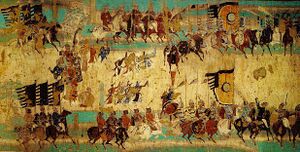
Altough numerically inferior, Bi Liao decided to give battle due to the fact the Degei cavalry appeared to have deserted Qu Hou and he expected his elephant squadron and the king's heavy cavalry to give him the decisive edge. Unbeknown to him the Degei had separated on purpose from the main army shortly after entering Ghanim and shadowed them at a distance, and were now rushing to approach his army from the rear. At the onset of the battle Farukh's elephants were sent charging against Qu Hou's center, nearly buckling it until concentrated volleys of fire arrows and rudimentary rockets caused the elephants to panic and turn back just as Bi Liao's infantry was charging, crashing into them and throwing their lines into a panic. Liao now tried frantically to rally his panicking men to face the Corummese charge while Farukh led his elite bodyguard forwards to buy the main force time to reorganize. As Liao's men slowly managed to bring the elephants down while losing ground to Hou's advance, the Degei nomad cavalry arrived at the battle, releasing several volleys that killed and wounded hundreds of men before charging into the rear of Bi Liao. This charge broke the morale of the joint army and sent it into panicked fleeing. Bi Liao was killed by Degei horsemen while trying to escape and his severed head was presented to Qu Hou, while King Farukh was captured and forced to prostrate before Qu Hou. In the aftermath of the battle the kingdom of Ghanim retained its independence but was was forced into becoming a tributary of the Chen dynasty, handing over both the infant Shang pretender, the king's own heir as a hostage and the fertile plains around Lake Doyeon to the Chen. The fate of the child emperor of the Shang is unclear after this, the most common theory being that he was asphixiated with a pillow on his way back to the Chen court.
The Four Great Impostors
Following the great victory at Horoz and with its western flank now secured, the Chen dysnasty appeared to be finally solidifying its position and for the next fifteen years would turn inwards in what is known as the Short Spring Awakening. A widespread purge of corrupt officials led to improved governance in the provinces and increases in collected revenues for the central treasury. Building of a new palace and tomb complex for the dynasty in the Mengguan hills began in this period. Shang remnants however were not completely erradicated at Horoz and several grandees continued to hold out in the countryside throughout the Short Spring Awakening. In 877 the first of the great impostors arose in the western province of Kuchil; claiming to be Emperor Cao Fu returning to claim his inheritance. An army of Shang loyalists, disgruntled officials and bandits soon coalesced around him and defeated an army led by Kuchil's governor sent to stop him. By 879 another Chen army had been defeated, the king of Ghanim sensing an opportunity to shake off Chen vassalage began to support the false Cao Fu with money and supplies. As he marched on Dagu, the false emperor died poisoned possibly by a member of his inner circle aiming to secure a pardon by the government. Although his army attempted to maintain its cohesion, its lack of a figurehead saw many desertions before being ambushed and defeated in the outskirts of the capital.
The second of these pretenders, Tengu Peg Leg, first rose in the city of Heng in 896. Claiming descent from the last Shang emperor, he and his supporters took over the city administration by force and gained the support of its citizens by abolishing taxes for three years and promising to give every citizen five slaves from towns he conquered. Other cities in the region expelled their imperial garrisons and approached Tengu for protection and relief from imperial taxation . With these defections the territory controlled by Tengu's loyalists grew to cover all of the Corummese northwest. He declared himsef emperor with Heng as his capital and styled his domain as Northern Shang. The loss of important economic centers like Heng and control of important trade routes to the north represented a heavy blow to the Chen dynasty's finances and hobbled its capacity to respond quickly.
Alarmed by the rapid rise of Tengu and the gathering defection of the northwest provinces to him, in 905; after almost five years of revolt, the weakening Chen dynasty appointed a certain nobleman named Da Beipan, who would later found the Zhong dynasty, to the post of Titanic Captain of the West to deal with the rebellion. Da Baipan mustered and trained his imperial forces of roughly 130,000 men for six months before moving his army straight into Tengu's territory. Da Baipan proceeded to invest the walled city of Sho Heng, attempting to storm the city twice but being repulsed. Settling on starving the city out, he was confident that Tengu's army was smaller than his own and would not approach to give him battle. This would prove to be a mistaken assumption as Tengu's 200,000 strong army force marched its way towards Heng barely two months into the siege. Despondent at being so outnumbered and with the possibility of being pinned against the city walls, Da Baipan abandoned the siege and began making his way back to Zhong territory.

Overtaken at the Catun Fields, the vanguard of Tengu's army clashed with the imperial force, badly mauling it in a pitched battle and sending it running from the field. Baipan's army was now at the mercy of his foe. The defeat of Genera Da Baipan by the forces of Northern Shang at the Catun fields left him in a precarious political position at the Chen court. Knowing that his enemies would be calling for his execution, he made the fateful decision to arrange for a truce with Northern Shang and turn his army around in revolt against the Chen dynasty. Proclaiming the Zhong dynasty, he marched his way back to the east and began a 10-year campaign to deprive the Chen of support and cut off the capital. For this revolt, Da Baipan is called the Third Great Impostor. The Chen began forming an army composed mostly of recruits and horsemen from among the northern Degei commanderies under the command of the eunuch Wu Zhao, an experienced battle commander. Paranoia over employing native Corummese units who might defect kept them from calling other forces at their disposal, preferring to keep them as armies in place that the Zhong might have to maneuver around. In any case most of these forces defected or dispersed when the Zhong entered their areas of responsibility, seeing the Chen as a rotting carcass who could rule no more. In 916 Wu Zhao's army first clashed with Zhong forces at Mouyi, routing one of Da Beipan's lieutenants and capturing three thousand men.
Defeating an army led by Duke Kimm sent to check his advance near the town of Sashun. The battle was significant in that Kimm's army was the last significant force the Chen could field that could be used to protect the capital, as other forces were too far away or were abstaining from the fight, waiting to throw their support for whoever was victorious at the capital. Kimm was executed by the rebels but his defeated army agreed to join with Da Baipan. The Chen court attempted to negotiate with their rebellious general and Baipan agreed in what is generally accepted to have been a ruse for time. His true aim to be gaining time while he negotiated in secret with sympathetic nobles on surrendering the capital. By the summer of 910, Zhong forces were only ten kilometers from the capital, holding an incontestable superiority in men, supplies and access to siege equipment to the defenders of the capital. A cabal of nobles rode out to meet with Da Baipan and placed before him the head of Emperor Waguo of Chen, surrendering the city and signifying the death of the Chen dynasty. Zhong forces marched into Daguo to great fanfare with Da Baipan taking the regnal name of Emperor Gong.
Zhong Dynasty
Having unseated the Chen dynasty by treachery and with the stain of defeat on the battlefield against Northern Shang, Emperor Gong of Zhong wanted nothing more than to raise new armies to reclaim what he saw as imperial territory in revolt. However the destruction caused by his own insurrection, the pressure on a depleted treasury to pay the wages and bonuses of his standing army and a restless population that were tired of war and high taxes were insurmountable obstacles to realizing his ambition of fully reunifying the empire in the short term. By 918 the northern nomad commanderies were close to revolt, with pro-Corummese nobles and officials being forced to flee their lands by a certain Darukh Khan agitating to reunify the tribes under his command. Darukh Khan was the son of a local Degei chief and functionary and had served in a Chen cavalry unit. Angered by the reduction of imperial stipends going to local chiefs and the resulting disruption of local patronage, Darukh Khan renounced his Corummese titles and began arresting Zhong tax collectors. Darukh Khan proved to be a charismatic orator for he was able to convince thirteen other clan chiefs to follow suit and mount an attack on the garrison town of Baliq where they killed the town guards, shaved the moustache of the local magistrate before kicking him out of town and forced the townspeople to prostrate themselves before Darukh. Darukh proclaimed himself Great Khan of the Degei, a title that implied universality of his rule, Corummese historians name him as the Fourth Great Impostor of the period for his ambition was to rule not just his fellow nomads but to advance south into the empire.
Wars against the United Cities
Main Article: United Cities
Conquest of Ghanim
Vassalization of Canpei
Duamacia-Corumm Border Wars
Qian Dynasty
Exploration of Australis and colonization of Stenza
Economic and Military Modernization
Second Great War
Glorious Revolt
Republican Period
National Reconstruction Front-PRI analogue but more military men involved/War of attrition in Xingkaipei/Building up of communists and other groups of opposition(infiltration of said groups/government assets as leaders) as boogeymen to shore up regime support
One Party Period
Rise of the Party of Corummese Democrats
Struggle against internal enemies and consolidation
Liquidation of the Left
By mid-1993 the Bureau of State Protection had been given the directive to begin the repression of the Communist Party of Corumm (CPC) and its armed wing, the Army of Common Men (ACM). Operation Dendron decapitated the communist political leadership and left the party directionless however the cell structure of the ACM prevented most of its leaders from being found out and killed. This operation also had the secondary effect of rendering the CPC and the political path almost irrelevant in the conflict to come. Dendron marked the beginning of a bloody period of state terrorism as the government sought to crush the armed resistance of the ACM by any means necessary. Hundreds of thousands of left-wing activists, students, journalists, writers and anyone suspected of sympathizing with the political left were imprisoned, tortured and killed. The ACM responded by unleashing a wave of terrorist bombings, hit and run attacks on military and police targets and killing of government employees as reprisals. Increasing efficiency in intel gathering on the ACM resulted in the design and implementation of Operation Eschaton, which succeeded in killing hundreds of leadership figures all across the country. Finding itself increasingly cornered in urban areas by the security organs, the bulk of the ACM moved into the countryside whilst leaving only smaller three-man cells in the cities. In rural areas the organization had a degree of grassroots support, especially in the poorer west part of the country. PCD initiated security reforms had not yet reached these locales and the local security forces were too weak to suppress the ACM on their own. While the ACM had appeared to be on the backfoot or even the edge of defeat at the end of 1995, its move to the countryside allowed it breathing room to reconstitute itself and Operation Eschaton had not yet taken an irreversible toll. It coerced peasants to join its force in increasing numbers and began expanding an area of actual territorial control that surrounded several provincial cities. By the summer of 1996 the ACM had recovered in numbers and stormed the city of Khov, defeating the local garrison and with the local police force fleeing without a fight. The ACM declared a Khov Socialist Republic and invited the 'revolutionary' sectors of the city to join its forces.
The government responded by initiating a special combined operation by Army and BSP battalions to clear the city and the surrounding area. Power and water were shut off to the city, roads blockaded and supplies turned back while a massive artillery bombardment began. ACM forces attempted to repeatedly break the siege by using truck bombs and exploiting the temporary gaps created but air power turned them back everytime. After two months of sluggish advance amid heavy fighting, the government was in position to assault Khov and did so starting in September 1996. Of note in the Battle of Khov is the participation of a new entity called the Peace Brigade, which had links but was not subordinated to the BSP. It is rumored however that the Peace Brigade was the brainchild of Prib Dodd, head of BSP at the time. Three more weeks of fierce urban fighting ensured that most of Khov was destroyed and the brutality of the Peace Brigade made sure most of the population followed their city into oblivion. Only three members of the ACM's Directorate survived the battle and fled the fall of the city using tunnels dug under the city, escaping further west.
After the decimation of the ACM at Khov and the end of their territorial experiment, the vacant Directorate seats were slowly filled by BSP infiltrators acting upon Operation Maniphage. If the ACM's leader was not a government agent by this point, he was certainly surrounded by them. The new Directorate blamed the conservative leanings of the peasantry and their lack of revolutionary zeal as the root causes for the defeat and moved to suppress them. During 1997 the ACM razed close to a hundred villages, stealing crops and cattle, massacring the inhabitants and conscripting the children into its forces. Crafted by the architects of Operation Maniphage, these attacks caused a decisive break between the ACM and the western countryside. This also led to schisms to break out in the ACM, with at least two members of the Directorate(non government assets) leaving the organization and branding it insane and terroristic. With insider information of the organization's movements, the BSP hunted down its remaining cells in quick succession during 1997 and early 1998. Chancellor Linge Chen declared the organization defeated in a speech to the People's Assembly on May 1st 1998.
The House of Troubles
The Xingfu Dejia or House of the Blessed Brothers was a self help cult that had been growing in the country since at least 1985. The weakened NRH government tried to supress it at first but eventually gave up and allowed it to operate freely, perhaps hoping to complicate things for opposition groups if they took power. After the accession of the PCD-led government, things changed for the movement and it began to be more closely scrutinized for signs of subversive activities. Harassment by authorities contributed to the radicalization of the groups founder, Min Yaaj Zoov who became more dictatorial and began indoctrinating his followers towards violent action.
Suppression of the Right
The persecution of the leftists was widely applauded and supported by the business class, especially the plutocrats that had benefitted by the cronyism of the military government that preceded the PCD. They mistook the government's savage attack on socialism as a sign that it intended to loosen even more its grip on the economy, perhaps by handing over control of strategic sectors to private capital. This mistaken conception would cost them dearly as the organs of terror began working again and the totalitarian nature of PCD thinking revealed iself in full. The BSP's systems of mass surveillance under Operation Panoptes had been in full swing since 1992 and the wealthy were not exempt. In March 1999 around fifty of Corumm's wealthiest businessmen were arrested and taken to Building 82, their personal bank accounts and those of their companies already frozen. With notaries present and under threat of torture or death they were forced to sign their assets away into the hands of the government. In a single move the Party acquired control of 25% of the nation's economic assets including industrial complexes, banks, mines, agricultural lands, hotels, commercial fisheries and much more.
Invasions of Crona
Geography and Ecology
Climate
Corumm experiences a combination of continental climate and an oceanic climate, but most of the country experiences a humid continental climate within the Köppen climate classification scheme. Winters bring clear weather interspersed with snow storms as a result of northern and northwestern winds. Summer tends to be by far the hottest, most humid, and rainiest time of year because of the southern and southeastern monsoon winds that carry moist air from the Omnium Sea. Approximately 60 percent of all precipitation occurs from June to September. Spring and autumn are transitional seasons between summer and winter. The daily average high and low temperatures for Mirzak are −3 and −13 °C in January and 29 and 20 °C in August.
Geography
Geographically notable are the Arik Mountains which dominate most of western Corumm and served as an important geographic barrier against other powers. Nestled among this mountain range is Lake Doyeon, a large lake with a tributary river that is a vital source of water and gives way to fertile plains on which much of Corummese agriculture is based.
-
Northern steppe region at Ulug.
-
Lake Doyeon high up in the Arik Mountains.
-
Forested meadow in the Mirzak countryside.
Ecology
Corumm has a vibrant array of animal and plant life within its borders, both natural and transplanted by less than careful travelers. It is home to the largest predator in Alshar, the hyena-like Long-toothed Hound or Zhangya. Also endemic is the 'Corummese chicken' or Giswi which has been domesticated and turned into an inexhaustible source of food. Some of the outlying islands have specimens reminiscent of past eras of the world such as giant flightless birds such as the Danonino, which have survived due to the isolation of their habitats.
Government & Politics
Government
According to the Constitution of Corumm, the country is a federal republic, wherein the Chancellor is both head of state and head of government. The Republic of Corumm is fundamentally structured as a multi-party representative democracy. The government of Corumm follows the conventional republican structure with three branches that in theory function independently of each other and serve to maintain a balance of power in the system. The constitution of 1993 created by the a legislature dominated by the PCD however tinkered with the system and did away with any pretense of balance, first by abolishing the post of President and replacing it with a Chancellor with much beefed up powers, with critics complaining that its outsized powers are more fit to an Emperor than to the head of a democratic system. The second change was the abolishment of the Senate with the remaining body being renamed to the People's Assembly and enlarged to five hundred members, still elected by direct vote but carefully vetted by the Bureau of State Protection. The Judiciary saw a quick erosion of its independence, with the Supreme Court expanded from seven to eleven members(all new members with clear sympathies for the PCD). The organ in charge of the designation of lower level judges and magistrates was folded into the control of the Ministry of Interior. These and other constitutional changes guarantee the absolute primacy of the executive branch, with the legislative and judicial as subservient junior partners and rubber stamps.
- Executive: The Chancellor is the Supreme Commander-in-Chief of the Armed Forces, can veto legislative bills before they become law, and appoints the cabinet and other officers, who administer and enforce federal laws and policies.
- Legislative: The unicameral Assembly of the People, made up of the 500-members, adopts federal law, declares war and approves treaties. The Party of Corummese Democrats has maintained an absolute majority since 1992.
- Judiciary: The Supreme Court and lower federal courts, whose judges interpret laws and can overturn laws they deem unconstitutional.
The Chancellor is elected by popular vote for a six-year term. There are no term limits in place.
The Party
Main Article: Party of Corummese Democrats
Judiciary
Law Enforcement
See also: Bureau of State Protection
Administrative Divisions
| Province | Capital | Chief Minister | Population |
|---|---|---|---|
| Central | Mirzak | Hao Fard | tbd |
| Yang | Daguo | tbd | tbd |
| Zong | Zong | tbd | tbd |
| Liyuan | Menshen | tbd | tbd |
| Ganshi | Domin | tbd | tbd |
| Henyin | Akkan | tbd | tbd |
| Chesad | Mimban | tbd | tbd |
| Yirrg | tbd | tbd | |
| Khov | Khov | tbd | tbd |
| Heng | Heng | Tbd | tbd |
| Leng | Korell | tbd | tbd |
| Uxos | Dom Dode | tbd | tbd |
| Mung | Minxia City | tbd | tbd |
| Liao | Datlof | tbd | tbd |
| Mulm | Urum | tbd | tbd |
| Ruusan | Kaan | tbd | tbd |
| Sanyu | Hecore | tbd | tbd |
| Huzb | Harras | tbd | tbd |
| Pingu | Zhongzi | tbd | tbd |
| Cheng | Bodis | tbd | tbd |
| Xisheng | Kov'Anilessa | tbd | tbd |
| Cao | Kogorun | tbd | tbd |
| Zhijun | Yishi | tbd | tbd |
Military
Main Article: Corummese Armed Forces
Foreign Relations
Main Article Corumm's Adversarial Table of Relations The Corummese state maintains diplomatic relations and maintains embassies with almost every nation in the world. The unique nature of Corummese practices and national outlook at times cause suspicion and resentment in the 'Western World'. Nonetheless Corumm maintains excellent relations with many countries, often of a transactional, non ideological nature and always pursuing the win-win model of interaction.
Demographics
The 2027 national population census of Corumm determined the total population to be 744,900,597 with a net population growth of around 0.6% per year. Population growth has slowed down from around 1% in the last two decades due to concerns about overcrowding and deleterious effects on social services. Emmigration restrictions and limitations post 1992 contribute to minimal population outflows, other than to a few authorized destinations. Non Corummese ethnicities have significantly higher birth rates leading to forming majorities of the population in certain localities.
Ethnicity
The ethnic makeup of Corumm has been relatively stable through history, with a mostly homogenous ethnic Corummese majority that has persisted into modern times. Nomadic groups and polities from the north and northwest that historically existed and settled in the borderlands such as the Degei and Duoman peoples were gradually incorporated and some of their customs and fragmentary portions of their languages appropiated by the Corummese. The conquests of the Oduniyyad brought new groups of completely distinct peoples to the eastern borders of Corumm, from dusky brown Umardis to charcoal skinned Audonians, these new arrivals left their influence in the eastern peripheries through holy wars, trade and slavery. This gave rise to a local syncretism and intermingling between Audonian and Corummese cultures and languages that continues to this day. In the modern era eastern Corumm continues to be the most diverse part of the country albeit not without the existence simmering ethnic tensions only kept at bay by heavy handed government control.
Language
extra vowels, how and extent of spread into east alshar, its use as a tool of expansionism and suppression of other cultures
Religion
Comments on ancient corummese religious practices, how it was viewed by Imperial bureaucracy, position of religious figures in corummese society and such. Preponderance of cults in late empire era. Modern state enforced atheism and its effects on religiosity
Education
Teaching methods, notable educational institutes, government propaganda and brainwashing in post-1992 schools
Culture
Architecture
Something about traditional chinese architecture, also eastern styles for ironically, western corumm
Cuisine
-
Fried spring rolls with pork
-
Fried chicken taco with lettuce
-
Rice and Kai Kiu chicken
-
Yinmoh, dried maize kernel soup
-
Fish fillet with butter and spices
-
Chef Boyardee aspic
-
Marinated pork
-
Fish with garlic sauce and lemon
-
Slozo, fermented milk
-
Naiyou, a milk based creamy dessert
-
Caramel custard, known locally as Buding
-
Anyong Palmeng iced tea
Corummese cuisine is complex and ancient, developing over centuries of human habitation in the Corummese heartlands. Most of the ingredients are native to the country but others have been incorporated or introduced by interaction with neighboring peoples. Many Corummese classic dishes incorporate rice, wrapping breads made of maize or flour to make 塔可, meats such as pork, chicken and fish. Fried foods are very popular as street food especially spring rolls filled with vegetables and pork. Most Corummese desserts are milk based such as the 'Naiyou' creams or and the popular caramel pudding known as Buding. Drink wise there is an abundance of citrus and tamarind based drinks, the majority of the citrics used in Corummese dishes were introduced by traders from neighboring Rusana as were the green and black olives which are now also grown domestically. The wheat based Mijiu is a favored and cheap local alcoholic drink that competes with the milk based Slozo. Wine is only recently carving a small market niche for itself, mostly imported brands.
Set apart from traditional food is the gelatin based Corummese Aspic, a relatively recent invention out of the penitentiary system. Considered a disgusting and low class food by a majority of ethnic Corummese, consumption of aspic based meals has spiked among minorities due to its widespread availability, lower costs compared to traditional food, and extreme versatility in making 'more with less'. Supermarkets exclusively carrying Aspic food have sprung in ethnic and poor suburbs, with the brand Agario and its product line of 'Edible Inedibles' expanding to hundreds of locations. Certain laws also favor the spread of aspic in the Cronan territories, as they actively discourage native peoples from ingesting anything but aspic.
Corummese dining habits very much depend on an individuals social strata. Wealthy Corummese citizens typically have between five and eight meals a day of varying portion sizes, usually food binging in the latter three meals. Middle income and upper lower class people typically do three square meals a day, much as in the western world. Poor people and minorities however may scrape by with one or two meals a day, rarely having the time to eat at home but instead having their food at their work stations or cafeterias close by. Millions of Corummese workers survive on Agario fare or discounted Factory Gruel.
Music
Traditional Corummese music is loud, monotonous and without lyrics. Akin to sardaukar chant from dune
Media
Mass Surveillance
Corummese society is constantly watched for signs of political dissent or more mundane antisocial behavior that could be interpreted as 'Anti-Corummese'. A wide variety of methods are used to keep an eye out for the unruly. While the security services have traditionally favored the use of informants(rumored to amount to 2% of the population), in recent years there have been greater efforts to expand the monitoring of all online activity by enlisting the aid of telephone and cellphone companies, internet providers and media conglomerates. There is also a long running program to install surveillance cameras in all public places, with the stated aim to have 100% coverage of all major cities by 2040 and eventually create the largest CCTV network in the world. All smartphones available to the public come with a pre-installed application that monitors the users activity. The mass surveillance apparatus is under direct control of the Bureau of Political Orthodoxy(BPO) with local security agencies providing support when necessary.
Citizen's Loyalty System
The BPO has begun a pilot program to punish or reward citizens based on any number of variables such as perceived loyalty to the Party, online activity, travel to foreign countries, military service among others. Citizens with higher scores have preferential access to government jobs, loans from state banks, priority for university spots while low scores can result in restricted travel or the imposition of personal curfews. While the program is still in its infancy, the desired endgoal is for it to regulate every aspect of the citizen's life from birth to death. Corummese citizens living abroad are not exempt from this system of control and must routinely report to local consulates and embassies.
Reeducation Centers
The government runs an undisclosed number of reeducation facilities where it houses antisocial individuals and seeks to reform and reprogram them into useful members of society. Likened by opponents to gulag networks that exist under the communist model, the use of torture, brainwashing and mandatory origami lessons are allegedly widespread.
Economy
Main Article: Economy of Corumm
Overview
The Democratic Republic of Corumm possesses a mixed economy that combines elements of both a traditional and planned economy. While its GDP per capita of around $33,000 puts it squarely in the middle of the pack for individual incomes, its total national GDP of $23 trillion makes it one of the larger economies in the eastern part of the world. Most sectors of the economy; be it agriculture, manufacturing, defense, are dominated by a few oversized companies which often have sizable advantages over exterior competitors seeking to enter the Corummese markets. While there have been steps towards economic liberalization in the past decades such as reducing the mandatory, the State maintains a firm monopoly over many sectors of the economy seen as strategic such as the energy, communications and mining sectors while keeping in place at times not so subtle preferential policies towards native companies. Coming out of an economic downturn in the late 1990's, the opening of new markets and acquisition of vast natural resources due to the aggressive expansion into Crona has seen a massive expansion of economic activity in the present day. While not openly recognized, foreign experts assess up to ten percent of the national economy is controlled by members of the ruling Party through a vast network of companies both fictitious and real, with sums of money in the billions of lira remaining outside the purview of the tax authorities. The complete blurring of divisions between the Corummese state and the ruling party make getting detailed information nigh impossible. The Central Bank of Corumm(CBC) regulates private banks, prints currency and manages monetary policy with great emphasis placed on maintaining stable prices. The Central Bank is also in possession of the national gold reserves, maintaining several undisclosed locations for this purpose. The national currency is the Corummese Lira (ç).
Currency
Agriculture
Meat Sector
Main Article: Meat Sector of Corumm
The Corummese meat industry is the largest of the sector in Alshar. The corummese beef market is estimated an approximate 200 billion taler, owing to a diet traditionally heavy on meat. Favorable conditions including vast grazing areas, government subsidies and campaigns to promote meat eating have contribuited to the sector going from strength to strength. Growth and demand of the sector is being fed by the introduction of meat cuts into north Crona diets via new retail channels, the availability of extra grazing areas in Xisheng and Tanhai and favorable export agreements with various international clients. The majority of the sector's leading companies are members of the Federation of Corummese Beef Producers, a cartel like organization that controls most commercial aspects of the beef industry.
Energy
Industry
Manufacturing
Arms Industry
Mining
note to self: underground mining habitats/towns, indentured miners/children forced to work mines to pay off parental debts

